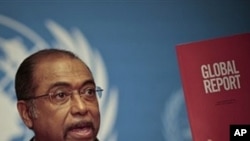A new report shows the AIDS epidemic has been halted and the world is beginning to reverse the spread of HIV, the virus that causes AIDS. UNAIDS, the joint U.N. Program on HIV/AIDS reports at least 56 countries have stabilized or achieved significant declines in rates of new HIV infections.
UNAIDS Executive Director, Michel Sidibe, loses no time in announcing the good news.
"Today, we can say with confidence and conviction, that we have broken the trajectory of the AIDS pandemic," Sidibe said. "Less people are becoming infected. Less people are dying. New infections have fallen by nearly 20 percent in the last 10 years."
Data from the UNAIDS report shows an estimated 2.6 million people were newly infected with HIV in 2009, down from 3.1 million in 1999. It notes 1.8 million people died from AIDS-related illnesses last year. This is one-fifth lower than in 2004. It says more than 33 million people are living with HIV, thanks to anti-retroviral therapy.
The report says sub-Saharan Africa continues to be the region most affected by the epidemic, with 69 percent of all new HIV infections. But, even this region is wracking up huge successes.
It notes HIV epidemics in sub-Saharan Africa are stable or declining, AIDS-related deaths are going down and HIV infections and AIDS-related deaths are declining among children.
Deputy Executive Director of UNAIDS, Paul De Lay says 22 countries in sub-Saharan Africa have reduced new HIV infections by more than 25 percent and this is happening in the general population, particularly among young people.
"We are seeing a decrease in the number of sexual partners," De Lay said. "We are seeing in some countries up to 75 percent use of condoms and less casual sex act. We are seeing delays of sexual debut. So, the basic sexual risk behaviors are changing dramatically. What we have not seen is the impact of increased treatment because increasing numbers of people on treatment will also contribute to prevention."
But, the news is not uniformly good. The report finds a steep increase in new HIV infections and AIDS-related deaths in Eastern Europe and Central Asia.
The report says the number of people living with HIV almost tripled between 2000 and 2009 to an estimated 1.4 million. The HIV epidemics are mainly found among people who inject drugs, sex workers, and men who have sex with men. Most of these infections are in Russia and the Ukraine.
The report warns the HIV epidemic is not over in high-income countries in North America and Western Europe. It says unprotected sex between men mainly accounts for the spread of new HIV infections.
It says HIV disproportionately affects African-Americans in the United States and aboriginal people in Canada.
UN: New Cases of HIV Decline
- By Diaa Bekheet











